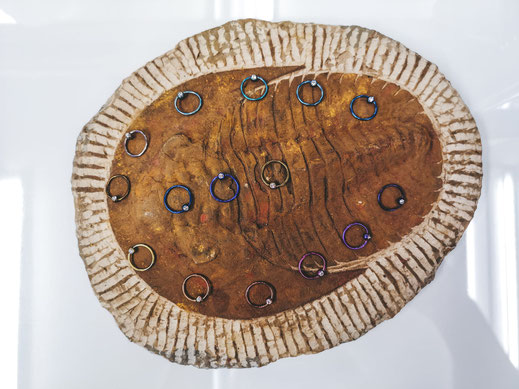BEFORE A NEW PIERCING
Before getting a piercing, it’s important to take several steps to ensure a safe and successful experience:

Research:
Learn about the type of piercing you want, including the healing process, potential risks, and aftercare requirements.
Choose a Reputable Piercer:
Find a licensed and experienced professional. Look for reviews, ask for recommendations, and visit the studio to ensure it follows proper hygiene practices.

Health Considerations:
Make sure you’re in good health. If you have any medical conditions or are taking medications that could affect healing, consult your doctor beforehand.

Consultation:
Have a consultation with your piercer to discuss the procedure, ask questions, and address any concerns you might have.


Eat Well:
Have a good meal before your appointment to help keep your blood sugar levels stable.

Aftercare Supplies:
Purchase any necessary aftercare products recommended by your piercer, such as saline solution for cleaning.
Avoid Alcohol and Blood Thinners:
Don’t consume alcohol or take blood-thinning medications (like aspirin) before your appointment, as these can increase bleeding.

Wear Comfortable Clothing:
Choose clothes that will not interfere with the piercing area. For example, wear a loose top if getting a navel piercing or avoid tight hats for an ear piercing.

Taking these steps will help ensure your piercing experience is as smooth and safe as possible.
Age & ID Requirements
How old do you have to be to get a piercing?
Belgian law does not set age limits in relation to piercings. However, at Skin & Sins studio we have set some age restrictions, mainly to give your new piercing the best chance of healing.
Ages and Requirements for Specific Piercings
8 - 12 years: only lobe piercings (earlobe)
We start piercing in the earlobe from the age of 8. So babies cannot be pierced with us.
Earlobes - Minors must be able to verbally consent to the piercings, as well as legibly write their name on the release form.
>14 years: helix piercing (cartilage on outer edge of ear)
We place helix piercings from the age of 14. This is the only cartilage piercing we will place at this age. This is the "easiest" of the cartilage piercings to heal.
>15 years: all ear piercings, nose piercing (only accompanied by a parent/legal guardian and must provide identification and proof of age in order to be pierced).
A person of 15 can handle ear piercings well by now. Some ear piercings require a great deal of patience and care, such as an industrial or a daith piercing. We are confident that a 15-year-old can give the new piercing the care it requires and deserves.
A nose piercing or nostril piercing is one of the easiest facial piercings to heal, and we find that schools are starting to accept them as well. Therefore, we have recently lowered this age limit. Caution! Please check with school if this is allowed, because going to tape your fresh nose piercing every day can cause a lot of difficulties during healing.
16 - 18 years: facial piercings, navel piercing (only accompanied by a parent/legal guardian and must provide identification and proof of age in order to be pierced).
These piercing are already somewhat advanced. We set the limit of 16 years mainly because most parents also do not agree earlier that their child take this piercing, and also because schools often accept it only from this age.
Navel piercings are not done until the age of 16, because by then the body has already taken its final forms. Setting an umbilical piercing on someone who has yet to fully develop can again result in the piercing migrating or growing out. If an umbilical piercing grows out it can leave unsightly scars.
> 18 years: nipple piercings, tong and surface piercing, smiley
It goes without saying that we will only put nipple piercings on people 18 and older. Nipple piercings are considered intimate piercings, and as an adult piercer, we will therefore only do this on people who are of age.
For parents of teenagers:
If your child wants a piercing and you're not letting him or her get it, they will most likely do it themselves or find someone in school who will do it in completely unsanitary conditions. Unfortunately, there's an increasing number of people who deal with amateur piercing and tattooing because they think it's not a difficult job and that they know enough about it.
You can always come to our Skin % Sins studio, with your child or alone, to ask about the studio, tools used, jewelry, piercing consequences etc. If your child is getting pierced our studio, you can accompany him or her to see that everything used during the piercing procedure is sterile.
You can choose the color of your new jewelry: By Anodizing
Titanium, niobium, zinc, magnesium, aluminum alloys, and tantalum are all metals that can be anodized.
The color that is formed is dependent on the thickness of the oxide (this is controlled by the anodizing voltage). The interference of light reflecting off the oxide layer with the light actually traveling through said layer and reflecting off the metal underneath is what determines the color you see.
Copper, gold, green, purple, fuchsia and yellow are just a few of the colors that can be achieved through the anodization of titanium;
We can anodize Titanium in several brilliant colors.



